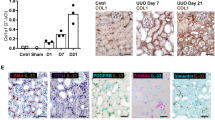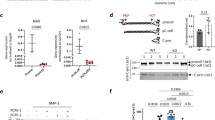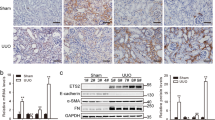Abstract
Regulation of the gene expression of Stromelysin-1 (matrix metalloproteinase-3), a member of the matrix metalloproteinase family, is critical for tissue homeostasis. The Stromelysin-1 promoter is known to be transactivated by Ets proteins through palindromic head-to-head Ets binding sites (EBS), an unusual configuration among metalloproteinase promoters. Patterns of increased co-expression of Stromelysin-1 and Ets-1 genes have been observed in pathological processes such as rheumatoid arthritis, glomerulonephritis and tumor invasion. In this context, we show in a synovial fibroblastic model cell line (HIG-82), which is able to co-express Stromelysin-1 and Ets-1, that the EBS palindrome is essential for the expression of Stromelysin-1. More precisely, using electrophoretic mobility shift assays, DNA affinity purification and chromatin immunoprecipitation, we demonstrate that endogenous Ets-1, but not Ets-2, is present on this palindrome. The use of a dominant-negative form of Ets-1 and the decrease of Ets-1 amount either by fumagillin, an antiangiogenic compound, or by short interfering RNA show that the activation rate of the promoter and the expression of Stromelysin-1 correlate with the level of endogenous Ets-1. Thus, it is the first demonstration, using this cellular model, that endogenously expressed Ets-1 is actually a main activator of the Stromelysin-1 promoter through its effective binding to the EBS palindrome.
This is a preview of subscription content, access via your institution
Access options
Subscribe to this journal
Receive 50 print issues and online access
$259.00 per year
only $5.18 per issue
Buy this article
- Purchase on Springer Link
- Instant access to full article PDF
Prices may be subject to local taxes which are calculated during checkout








Similar content being viewed by others
Accession codes
References
Andrews NC, Faller DV . (1991). Nucleic Acids Res 19: 2499.
Baillat D, Begue A, Stehelin D, Aumercier M . (2002). J Biol Chem 277: 29386–29398.
Barrett JM, Puglia MA, Singh G, Tozer RG . (2002). Breast Cancer Res Treat 72: 227–232.
Basuyaux JP, Ferreira E, Stehelin D, Buttice G . (1997). J Biol Chem 272: 26188–26195.
Bernier SG, Lazarus DD, Clark E, Doyle B, Labenski MT, Thompson CD et al. (2004). Proc Natl Acad Sci USA 101: 10768–10773.
Boyd KE, Wells J, Gutman J, Bartley SM, Farnham PJ . (1998). Proc Natl Acad Sci USA 95: 13887–13892.
Buttice G, Kurkinen M . (1993). J Biol Chem 268: 7196–7204.
Calmels TP, Mattot V, Wernert N, Vandenbunder B, Stehelin D . (1995). Biol Cell 84: 53–61.
Catalano A, Romano M, Robuffo I, Strizzi L, Procopio A . (2001). Am J Pathol 159: 721–731.
Chen JH . (1990). Oncogene Res 5: 277–285.
Chen YF, Shin SJ, Lin SR . (2005). DNA Cell Biol 24: 126–132.
Constantin A, Lauwers-Cances V, Navaux F, Abbal M, van Meerwijk J, Mazieres B et al. (2002). Arthritis Rheum 46: 1754–1762.
Crawford HC, Matrisian LM . (1996). Enzyme Protein 49: 20–37.
Datta B, Majumdar A, Datta R, Balusu R . (2004). Biochemistry 43: 14821–14831.
Dittmer J, Nordheim A . (1998). Biochim Biophys Acta 1377: F1–11.
Frisch SM, Clark EJ, Werb Z . (1987). Proc Natl Acad Sci USA 84: 2600–2604.
Frohman MA, Dush MK, Martin GR . (1988). Proc Natl Acad Sci USA 85: 8998–9002.
Gaire M, Barro CD, Kerr LD, Carlisle F, Matrisian LM . (1996). Mol Carcinogen 15: 124–133.
Galang CK, Der CJ, Hauser CA . (1994). Oncogene 9: 2913–2921.
Georgescu HI, Mendelow D, Evans CH . (1988). In Vitro Cell Dev Biol 24: 1015–1022.
Ghilardi G, Biondi ML, Caputo M, Leviti S, DeMonti M et al. (2002). Clin Cancer Res 8: 3820–3823.
Graves BJ, Petersen JM . (1998). Adv Cancer Res 75: 1–55.
Higashino F, Yoshida K, Noumi T, Seiki M, Fujinaga K . (1995). Oncogene 10: 1461–1463.
Hodge DR, Robinson L, Watson D, Lautenberger J, Zhang XK, Venanzoni M et al. (1996). Oncogene 12: 11–18.
Ingber D, Fujita T, Kishimoto S, Sudo K, Kanamaru T, Brem H et al. (1990). Nature 348: 555–557.
Iwasaka C, Tanaka K, Abe M, Sato Y . (1996). J Cell Physiol 169: 522–531.
Kirstein M, Sanz L, Quinones S, Moscat J, Diaz-Meco MT, Saus J . (1996). J Biol Chem 271: 18231–18236.
Kria L, Ohira A, Amemiya T . (1998). Curr Eye Res 17: 986–993.
Laemmli UK . (1970). Nature 227: 680–685.
Lin CW, Robbins PD, Georgescu HI, Evans CH . (1996). Exp Cell Res 223: 117–126.
Lowther WT, Matthews BW . (2000). Biochim Biophys Acta 1477: 157–167.
Majerus MA, Bibollet-Ruche F, Telliez JB, Wasylyk B, Bailleul B . (1992). Nucleic Acids Res 20: 2699–2703.
Malemud CJ, Goldberg VM . (1999). Front Biosci 4: D762–D771.
Man AK, Young LJ, Tynan JA, Lesperance J, Egeblad M, Werb Z et al. (2003). Mol Cell Biol 23: 8614–8625.
Maroulakou IG, Bowe DB . (2000). Oncogene 19: 6432–6442.
Mauviel A . (1993). J Cell Biochem 53: 288–295.
Mukherjee T, Kumar A, Mathur M, Chattopadhyay TK, Ralhan R . (2003). J Cancer Res Clin Oncol 129: 430–436.
Naito T, Razzaque MS, Nazneen A, Liu D, Nihei H, Koji T et al. (2000). J Am Soc Nephrol 11: 2243–2255.
Nelson AR, Fingleton B, Rothenberg ML, Matrisian LM . (2000). J Clin Oncol 18: 1135–1149.
Oikawa T, Yamada T . (2003). Gene 303: 11–34.
Ozaki I, Mizuta T, Zhao G, Zhang H, Yoshimura T, Kawazoe S et al. (2003). Hepatol Res 27: 289–301.
Paumelle R, Tulasne D, Kherrouche Z, Plaza S, Leroy C, Reveneau S et al. (2002). Oncogene 21: 2309–2319.
Pufall MA, Graves BJ . (2002). Annu Rev Cell Dev Biol 18: 421–462.
Pufall MA, Lee GM, Nelson ML, Kang HS, Velyvis A, Kay LE et al. (2005). Science 309: 142–145.
Quinones S, Buttice G, Kurkinen M . (1994). Biochem J 302 (Part 2): 471–477.
Radisky DC, Levy DD, Littlepage LE, Liu H, Nelson CM, Fata JE et al. (2005). Nature 436: 123–127.
Redlich K, Kiener HP, Schett G, Tohidast-Akrad M, Selzer E, Radda I et al. (2001). Arthritis Rheum 44: 266–274.
Rekdal C, Sjottem E, Johansen T . (2000). J Biol Chem 275: 40288–40300.
Rodriguez-Nieto S, Medina MA, Quesada AR . (2001). Anticancer Res 21: 3457–3460.
Rothhammer T, Hahne JC, Florin A, Poser I, Soncin F, Wernert N et al. (2004). Cell Mol Life Sci 61: 118–128.
Sato Y, Abe M, Tanaka K, Iwasaka C, Oda N, Kanno S et al. (2000). Adv Exp Med Biol 476: 109–115.
Sin N, Meng L, Wang MQ, Wen JJ, Bornmann WG, Crews CM . (1997). Proc Natl Acad Sci USA 94: 6099–6103.
Singh S, Barrett J, Sakata K, Tozer RG, Singh G . (2002). Curr Drug Targets 3: 359–367.
Span PN, Manders P, Heuvel JJ, Thomas CM, Bosch RR, Beex LV et al. (2002). Oncogene 21: 8506–8509.
Sternlicht MD, Lochter A, Sympson CJ, Huey B, Rougier JP, Gray JW et al. (1999). Cell 98: 137–146.
Sternlicht MD, Werb Z . (1999) In: T Kreis and R Vale (eds). Guidebook to the Extracellular Matix and Adhesion Proteins. Oxford University Press: New York, pp 505–563.
Sun HB, Yokota H . (2001). Bone 28: 303–309.
Terashima M, Akita H, Kanazawa K, Inoue N, Yamada S, Ito K et al. (1999). Circulation 99: 2717–2719.
Tokuhara K, Ogata Y, Nakagawa M, Shirouzu K . (2003). Int Surg 88: 25–33.
Trojanowska M . (2000). Oncogene 19: 6464–6471.
Vetter M, Blumenthal SG, Lindemann RK, Manns J, Wesselborg S, Thomssen C et al. (2005). Oncogene 24: 650–661.
Vu TH, Werb Z . (2000). Genes Dev 14: 2123–2133.
Wakiya K, Begue A, Stehelin D, Shibuya M . (1996). J Biol Chem 271: 30823–30828.
Wang J, Lou P, Henkin J . (2000). J Cell Biochem 77: 465–473.
Wasylyk C, Gutman A, Nicholson R, Wasylyk B . (1991). EMBO J 10: 1127–1134.
Wernert N, Gilles F, Fafeur V, Bouali F, Raes MB, Pyke C et al. (1994). Cancer Res 54: 5683–5688.
Wernert N, Stanjek A, Kiriakidis S, Hugel A, Jha HC, Mazitschek R et al. (1999). Angew Chem Int Ed Engl 38: 3228–3231.
Yamamoto H, Flannery ML, Kupriyanov S, Pearce J, McKercher SR, Henkel GW et al. (1998). Genes Dev 12: 1315–1326.
Yang BS, Hauser CA, Henkel G, Colman MS, Van Beveren C, Stacey KJ et al. (1996). Mol Cell Biol 16: 538–547.
Ye S, Whatling C, Watkins H, Henney A . (1999). FEBS Lett 450: 268–272.
Zhang Y, Griffith EC, Sage J, Jacks T, Liu JO . (2000). Proc Natl Acad Sci USA 97: 6427–6432.
Zucker S, Cao J, Chen WT . (2000). Oncogene 19: 6642–6650.
Acknowledgements
We thank Drs J Coll and Y Rouillé for generous gift of pSUPER constructs, Dr D Tulasne for practical guidance and C Lagrou for technical assistance. We are grateful to Dr V Fafeur and Dr V Mattot for providing pCDNA3-Ets-1dn construct. This work was supported by a grant from the Comité du Nord de la Ligue contre le Cancer. The Ligue Nationale contre le Cancer provided student fellowships for David Baillat and Gabriel Leprivier and a postdoctoral fellowship for Dr Nadejda Vintonenko.
Author information
Authors and Affiliations
Corresponding author
Rights and permissions
About this article
Cite this article
Baillat, D., Leprivier, G., Régnier, D. et al. Stromelysin-1 expression is activated in vivo by Ets-1 through palindromic head-to-head Ets binding sites present in the promoter. Oncogene 25, 5764–5776 (2006). https://doi.org/10.1038/sj.onc.1209583
Received:
Revised:
Accepted:
Published:
Issue Date:
DOI: https://doi.org/10.1038/sj.onc.1209583



